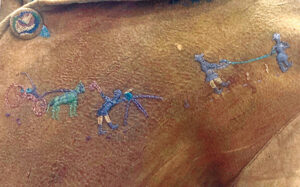Eye on the Esplanade: Traditional records
By Philip Pype on June 13, 2024.
Detail of Métis tunic, gifted to surveyor Frances Edward Armstrong, ca. 1880. On display now at the Esplanade.--PHOTO COURTESY ESPLANADE ARTS & HERITAGE CENTRE
“We come from storytellers, we love to tell stories, it is in our blood.” Fred Sasakamoose, author and first Treaty Indigenous player in the NHL.
Archives tell stories through the records preserved within our collections. We share them with visitors in the reading room, or with the public through social and traditional media, and our Online Collections Catalogue. Formal archives education taught me to think of archival items as mediums like letters on paper, photos, videos and computer files.
This limited mindset has kept archives, that often evolved as part of bureaucratic organizations, from fully representing the communities we are meant to serve. Opening our understanding of records to include anything that directly tells us someone’s story, whatever the media, greatly enhances the power of the archive. It helps us address some of the archival silences by enhancing the paper, photo, and audio-visual records created by cultural groups who have been historically excluded from formal processes.
I will give a few examples that I have encountered from Indigenous cultures near us.
My first encounter with an Indigenous record was in 2006, when the Esplanade exhibited the artwork of Allan Sapp, a Cree artist who recorded much of his life in acrylic paintings. I was absolutely fascinated by these works that were almost like photographs taken from his memories of childhood, growing up on the Red Pheasant Cree Reserve.
The Esplanade’s artifact collection includes various story-robes. Traditionally done on buffalo hides, these items detail Indigenous hunts, encounters, and recount other important events. The Mike Mountain Horse Story Robe, an item that has become quite famous, recounts Mike Mountain Horse’s experiences as a soldier during the First World War.
Another record that has strong standing in many Indigenous cultures but has not always been stored in archives is oral tradition, whether recorded or audibly passed along. Oral tradition provides direct human recollection and perspective that may never have been given credit in the official record; a community’s perspective may differ from that of a corporation or government.
The most recent example is currently exhibited in our reading room; a set of clothing on loan to us from Miywasin Friendship Centre. This outfit likely dates from about 1880 and belonged to surveyor Frances Edward Armstrong. It was likely made and gifted to him by a local Métis person when he was surveying in this area prior to the arrival of rail. The stitchwork below the collar of the tunic confirms the story that came with the outfit. In thread are a number of images, including a person, presumably Mr. Armstrong, using surveyor tools.
See this unique garment on display now. Not only is this piece classified as an artifact, it is also a record. It is currently displayed at the entrance to the Archives, off the gallery foyer. We’re open Tuesday to Saturday, noon to 5 p.m. and admission is always pay what you will.
Philip Pype is an archivist at the Esplanade Arts & Heritage Centre
11
-10
 Detail of Métis tunic, gifted to surveyor Frances Edward Armstrong, ca. 1880. On display now at the Esplanade.--PHOTO COURTESY ESPLANADE ARTS & HERITAGE CENTRE
Detail of Métis tunic, gifted to surveyor Frances Edward Armstrong, ca. 1880. On display now at the Esplanade.--PHOTO COURTESY ESPLANADE ARTS & HERITAGE CENTRE Detail of Métis tunic, gifted to surveyor Frances Edward Armstrong, ca. 1880. On display now at the Esplanade.--PHOTO COURTESY ESPLANADE ARTS & HERITAGE CENTRE
Detail of Métis tunic, gifted to surveyor Frances Edward Armstrong, ca. 1880. On display now at the Esplanade.--PHOTO COURTESY ESPLANADE ARTS & HERITAGE CENTRE